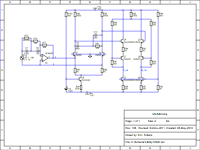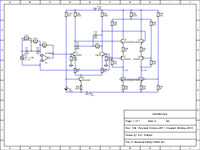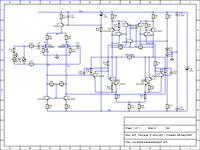The best amplifier in the world.
For now, of course. Once acknowledged there will be people to better details.
Why is this the best amplifier?
Well, in the beginning there was only the tube and amplifier technology evolved around tube properties. Hence the tube-amplifier. But then came the transistor!
And the transistor had a lot of properties to replace the tube. And that happened.
Where possible the tube was replaced by the transistor and audio gear sold claimed so much solid state. Claiming therefore to be better. And in certain aspects it was better, more reliable, less heat, more rugged and it had a opponent, a negative signal processing opportunity.
But never was a transistor-amplifier developed. Instead the transistorized-tube-amplifier turned into the well-known Operational amplifier, Op-Amp.
The tube has an infinitely high input-impedance, the op-amp with enough open loop gain simulates this as well.
The tube is a voltage gain device, the transistor a current-gain. Transistors need to process current in order to function correct. In the op-amp the transistors in the input and VAS get nearly no current to work with.
In practice this results into top-bands complain about the bad quality, lack of detail of their sound.
Top-bands! Top-bands who can afford and demand the highest quality audio-gear available complain. Those are musician who do hear the difference!
People who listen to MP3-players turn up the volume to ear scattering levels, damaging their ears.
Also by lack of detail.
Then there was a boy, a musician, who complained to his father that he could hear the difference between when he played and when listened back on the audio-set of his father. That audio-set was with a high quality op-amp-chip his father had put together from articles from the magazine, AudioXpress. So the father put up a test to compare his high-and amplifier to a modest tube amp.
And actually show the superiority of the tube! In scientifically detail. PROOF! AudioXpress, look it up!
This was never been done in the whole history of the Audio Engineering Society, AES! Proof.
The Op-Amp, convenient as it is, is not for audio. And should be abandoned from the audio world completely. Op-Amp, also called Instrumentation amplifier should be used for just that, instrumentation. To control or to monitor etc. Recording studio’s should throw away all their Op-Amp gear and replace it. Musicians will demand the better quality
The here presented circuitry offer a completely different approach to accomplish the best achievable in audio and can easily be modified to different applications or may even be bettered by skilled engineers. Bettered as long as the three main features are kept intact, balanced throughout, no overall feedback and by its True Class-A operation no demand on the power supply.
There is a power-amplifier and a phono. Phono is good for MC and for MM.
Also the phono amp can easily be adapted as a line-stage with tone control and the like.
All balanced and Class A
For now, of course. Once acknowledged there will be people to better details.
Why is this the best amplifier?
Well, in the beginning there was only the tube and amplifier technology evolved around tube properties. Hence the tube-amplifier. But then came the transistor!
And the transistor had a lot of properties to replace the tube. And that happened.
Where possible the tube was replaced by the transistor and audio gear sold claimed so much solid state. Claiming therefore to be better. And in certain aspects it was better, more reliable, less heat, more rugged and it had a opponent, a negative signal processing opportunity.
But never was a transistor-amplifier developed. Instead the transistorized-tube-amplifier turned into the well-known Operational amplifier, Op-Amp.
The tube has an infinitely high input-impedance, the op-amp with enough open loop gain simulates this as well.
The tube is a voltage gain device, the transistor a current-gain. Transistors need to process current in order to function correct. In the op-amp the transistors in the input and VAS get nearly no current to work with.
In practice this results into top-bands complain about the bad quality, lack of detail of their sound.
Top-bands! Top-bands who can afford and demand the highest quality audio-gear available complain. Those are musician who do hear the difference!
People who listen to MP3-players turn up the volume to ear scattering levels, damaging their ears.
Also by lack of detail.
Then there was a boy, a musician, who complained to his father that he could hear the difference between when he played and when listened back on the audio-set of his father. That audio-set was with a high quality op-amp-chip his father had put together from articles from the magazine, AudioXpress. So the father put up a test to compare his high-and amplifier to a modest tube amp.
And actually show the superiority of the tube! In scientifically detail. PROOF! AudioXpress, look it up!
This was never been done in the whole history of the Audio Engineering Society, AES! Proof.
The Op-Amp, convenient as it is, is not for audio. And should be abandoned from the audio world completely. Op-Amp, also called Instrumentation amplifier should be used for just that, instrumentation. To control or to monitor etc. Recording studio’s should throw away all their Op-Amp gear and replace it. Musicians will demand the better quality
The here presented circuitry offer a completely different approach to accomplish the best achievable in audio and can easily be modified to different applications or may even be bettered by skilled engineers. Bettered as long as the three main features are kept intact, balanced throughout, no overall feedback and by its True Class-A operation no demand on the power supply.
There is a power-amplifier and a phono. Phono is good for MC and for MM.
Also the phono amp can easily be adapted as a line-stage with tone control and the like.
All balanced and Class A
Attachments
...Recording studio’s should throw away all their Op-Amp gear and replace it...
They are. And going all digital. 😉
The bottleneck in recording studios seems to be personnel these days, not gear. But that's another story...
How does one set the gain in the power amp? 😕
The one in the Yamaha A-S1000/2000 looks broadly similar, but there I've found some gain-setting resistors at least...
(Oh, and the much more conventional A-S700 apparently performs better...)
How does one set the gain in the power amp? 😕
The one in the Yamaha A-S1000/2000 looks broadly similar, but there I've found some gain-setting resistors at least...
(Oh, and the much more conventional A-S700 apparently performs better...)
They are. And going all digital. 😉
Yes but stil need to import the analog world in. And by doing so with the Op-Amp, losing detail, there's no digitall thrick to recover that! The damage done leads to Bad Sound!
Edy
The input voltage is converted to a differentialcurrent by the diff-amp's emitter resistors. That current developes a voltage across the feedback resistors from the output.
Eddy
Eddy
And a Yamaha looks the same? I doubt that a japanese company can come up with someting original, But now I am curious to see that circuit too. Can you provide it for me? Would gratefull.
Eddy
Eddy
So far, so good. Got any formula for gain though?The input voltage is converted to a differentialcurrent by the diff-amp's emitter resistors. That current developes a voltage across the feedback resistors from the output.
Sure. You can download the service manual here. Obviously it has some differences (e.g. the output stage is a Darlington rather than a CFP), but you don't see balanced output amps every day.And a Yamaha looks the same? I doubt that a japanese company can come up with someting original, But now I am curious to see that circuit too. Can you provide it for me? Would gratefull.
Wel the formula is just to divade the output feedbackresistor by one emittor resister, that's all. A current gain infact.
Eddy
Eddy
Member
Joined 2009
Paid Member
I doubt that a japanese company can come up with someting original
don't believe everything you read. There are plenty of innovations that come out of Japan Inc. And there are plenty of innovations that are wrongly attributed - it seems who shouts "I did it" the loudest gets the recognition rather than the person who really did, and this can be a cultural issue.
Ofcourse you'r right, but all advertising I monitored especially from japanese companies are more a claim for something they "invented" and later on it appearse old wine in new bags. Valid, but from them.
Eddy
Eddy
The Japanese began their post war industrialisation by copying. Then they improved on the copies, then they actually created new technology. Nissan copied the BMW 1600 engine to produce the Datsun 510/1600 in the late sixties; in recent times, early nineties, BMW copied Toyota when they designed a V8. Now Japan does some of the world's best transistors, and it's difficult to argue with their expertise with tube amps - the WAVAC for example, not to mention the myriad 300Bs available today.
For some stunning originality, have a look at Kamijo's work here: http://www.ne.jp/asahi/evo/amp/guide.htm
Hugh
For some stunning originality, have a look at Kamijo's work here: http://www.ne.jp/asahi/evo/amp/guide.htm
Hugh
Last edited:
the best amplifier in the world
Strang that nobody recocnizes the quality presented here.
If I had the opportunty and money I start a company, manufacture them myself and everybody wil pay a lot of money for such a unieque sound.
If only I won the lottery. Pre-amplifier and power-amplifier
Eddy
Strang that nobody recocnizes the quality presented here.
If I had the opportunty and money I start a company, manufacture them myself and everybody wil pay a lot of money for such a unieque sound.
If only I won the lottery. Pre-amplifier and power-amplifier
Eddy
Having lived in Japan for nearly 5 years, I second your view Hugh.
There is lots of wonderful, original stuff out of Japan in any field you care to name.
I do wish humans would stop stereo typing each other!
There is lots of wonderful, original stuff out of Japan in any field you care to name.
I do wish humans would stop stereo typing each other!
- Status
- Not open for further replies.
- Home
- Amplifiers
- Solid State
- The best amplifier in the world


